Obstacles to Experience Management Expansion
Our research shows that organizations that master experience management (XM) outperform their peers. How? By applying the discipline of XM to continuously learn, propagate insights, and rapidly adapt they deliver better experiences to employees, customers, prospects, and partners. In fact, the more broadly organizations apply XM across multiple areas such as customer experience (CX) and employee experience (EX), the better they perform across multiple key performance indicators, such as employee retention, profitability, and revenue growth.
Despite the value of XM, organizations can struggle to spread XM–centric behaviors. We’ve found that change agents trying to drive XM success often run into similar obstacles:
- Functional silos. One of the natural obstacles to XM expansion is the existence of traditional organizational structures. For example, teams focused on EX generally sit within the HR function while those focused on brand experience (BX) may sit within Marketing. In many cases, these teams do not directly interact in the normal flow of work, and in some of the organizations we studied, have little visibility into the work of the other.
- Under-committed executives. In some of the organizations we analyzed, there were no true executive sponsors for XM. The most common scenario, however, was a senior executive who verbally championed XM but does little to secure budget, resources, and broader support among other senior leaders.
- Legacy XM teams. Another common obstacle to XM expansion is outdated skillsets within core XM teams. For example, many CX professionals are challenged with changing organizational perceptions that CX is unique from traditional Voice of the Customer (VoC) initiatives or even legacy customer service functions. These CX teams are often staffed with professionals that are specifically trained for those legacy functions.
- Pushy timeframes. One surprising obstacle that several organizations face is the desire of certain executives to accelerate XM expansion too quickly, without any allowance for natural adoption. While these efforts are almost always well-intended, this approach creates a significant supply of XM insights without the necessary demand across the business.
Introducing the XM Diffusion Cycle
To understand how organizations overcome the obstacles to XM expansion, the XM Institute studied the paths taken by nearly 50 organizations that have successfully expanded their XM efforts. Despite significant differences across their strategies and XM programs, these organizations described a common set of activities that led to their success. The same pattern showed up across customer, employee, brand, and product experience efforts.
We’ve labeled this pattern the XM Diffusion Cycle (XMDC), which we define as:
A repeating process that combines intentional and organic activities to drive the adoption of new XM-centric behaviors and capabilities
XMDC is made up of these three phases that have distinct characteristics 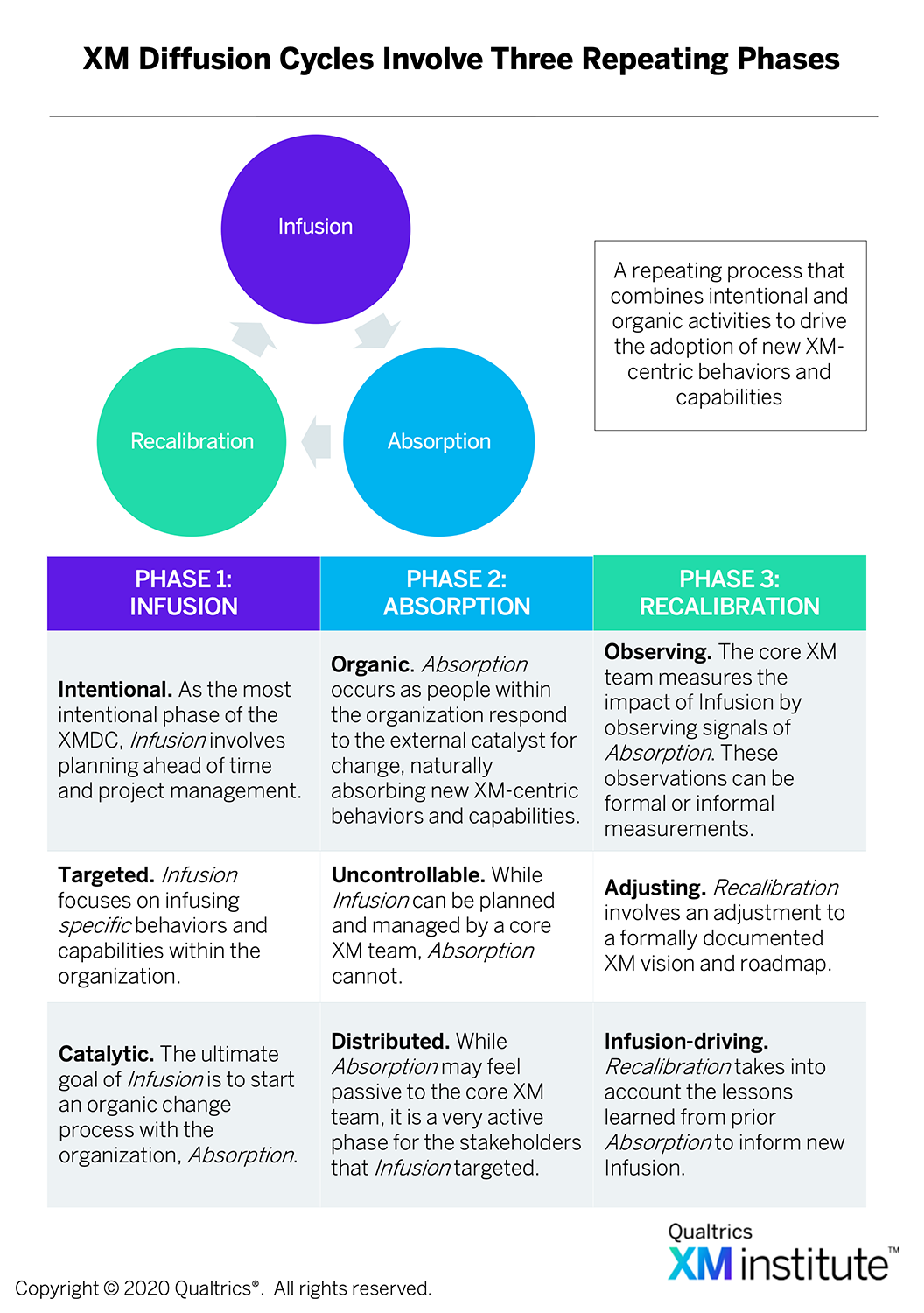 :
:
- Phase #1: Infusion. The diffusion cycle starts with intentional efforts that inject new XM–centric behaviors and capabilities within an organization.
- Phase #2: Absorption. As an organization absorbs the infusion, those initial changes are shaped by organic resistance and adjustments.
- Phase #3: Recalibration. Following absorption, XM teams need to recalibrate their future efforts based on an understanding of which changes spread or faltered, and what either inhibited or accelerated adoption.
Phase #1: Infusion
The first phase of the XMDC is Infusion. When implemented correctly, infusion tactics are gradually absorbed within departments and by leaders who were not directly involved in these efforts before. In other words, effective infusion efforts spur new demand for XM, build trust and buy-in among stakeholders, and change organizational behaviors.
This initial phase of the XMDC is:
- Intentional. Infusion efforts can and should be planned ahead of time and even project-managed, depending on their size and scope. For instance, one of the most common infusion tactics is to introduce self-guided dashboards of XM insights to business leaders. This process is intentional and often requires significant project management to accomplish.
- Targeted. Infusion focuses on spreading some new, specific behavior(s) throughout an organization. For instance, the introduction of self-guided dashboards is often to influence leaders’ behaviors to consume insights and take action on their own.
- Catalytic. The ultimate goal of Infusion is to start an organic change process (Absorption) within the organization. As indicated above, the intentional infusion effort of rolling out dashboards is ultimately intended to influence long-term, natural behaviors of leaders.
Phase #2: Absorption
At the end of the day, anything an XM team does won’t have a lasting impact unless some parts of their organization change how they behave. That’s what Absorption is all about, and it’s perhaps the most under-appreciated phase of the XMDC. Many XM efforts assume that other parts of their organizations will instantaneously and completely adopt changes that they propel. However, every infusion effort is met with a combination of adoption, resistance, and adjustment as organizations internalize the changes in their own way.
This second phase of the XMDC is:
- Organic. Absorption occurs as people within the organization respond to an external catalyst for change, naturally absorbing new XM-centric behaviors and capabilities. Forcing new XM-centric behaviors capabilities into the organization can be counterproductive and thus, this phase promotes their natural spread.
- Uncontrollable. While Infusion can be directly planned and managed by a core XM team, Absorption cannot be. While the ideal absorption signals can and should be identified ahead of time, the core XM team cannot directly control how the organization will react to an infusion effort.
- Distributed. One of the most challenging aspects of Absorption is that it often feels passive to the core XM team. This is often why organizations and core XM teams attempt to move too quickly. However, when done correctly, absorption is not passive at all, particularly for the stakeholders exposed to new XM-centric behaviors.
Phase #3: Recalibration
The final phase, Recalibration, follows each Infusion and Absorption phase. Essentially, Recalibration is a period of measurement and adjustment. As will be discussed later in this report, organizations that most effectively expand XM create a clear vision and roadmap at the forefront of their XM expansion efforts. This roadmap includes a sequence of infusion efforts and the ideal signals of absorption. This final phase of the cycle is focused on measuring those signals and making adjustments to the roadmap as needed.
This final phase of the XMDC requires a focus on:
- Observing. In Recalibration, the core XM team measures the impact of an infusion effort by looking for signals of absorption. Oftentimes, this measurement is informal and can be based on anecdotal evidence, such as having conversations with stakeholders about the utility of the new XM-centric behaviors. However, for large-scale XMDCs like organizational restructures, the signals may include formal measurements of usage and surveys of peoples’ reactions to the changes introduced.
- Adjusting. Successful XM expansion efforts start with an XM vision and roadmap. And since the XM roadmap is essentially a sequence of infusions and XMDCs, the Recalibration phase ends when the XM roadmap is adjusted.
- Infusion-driving. The purpose of Recalibration is to drive new infusion tactics that take into account lessons learned from previous Absorption phases. The protocols of the Recalibration phase are used to inform the core XM team on the immediate next steps. For example, if absorption did not occur as planned, the core XM team may choose to repeat the infusion tactic with a different audience or try a completely different tactic with the same audience. Alternatively, if absorption did occur, the team may move on to the next logical infusion that builds upon the first.
Applying the XM Diffusion Cycle
When the XMDC is successful, the use of XM expands across an organization. We found that the deployment of XMDC differs based on how widely XM is already embedded across an organization. To understand this phenomenon, let’s look at our four stages of XM expansion 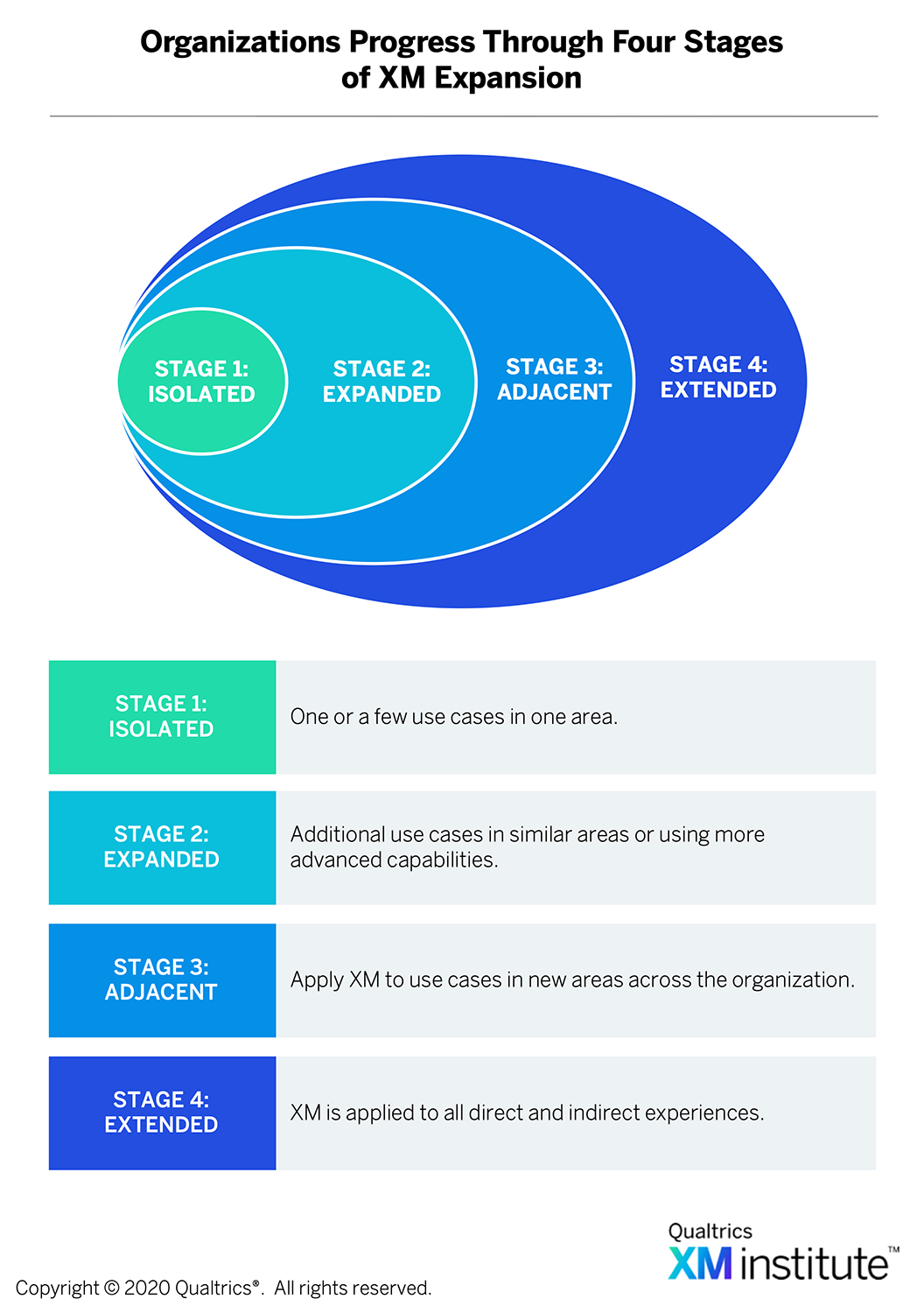
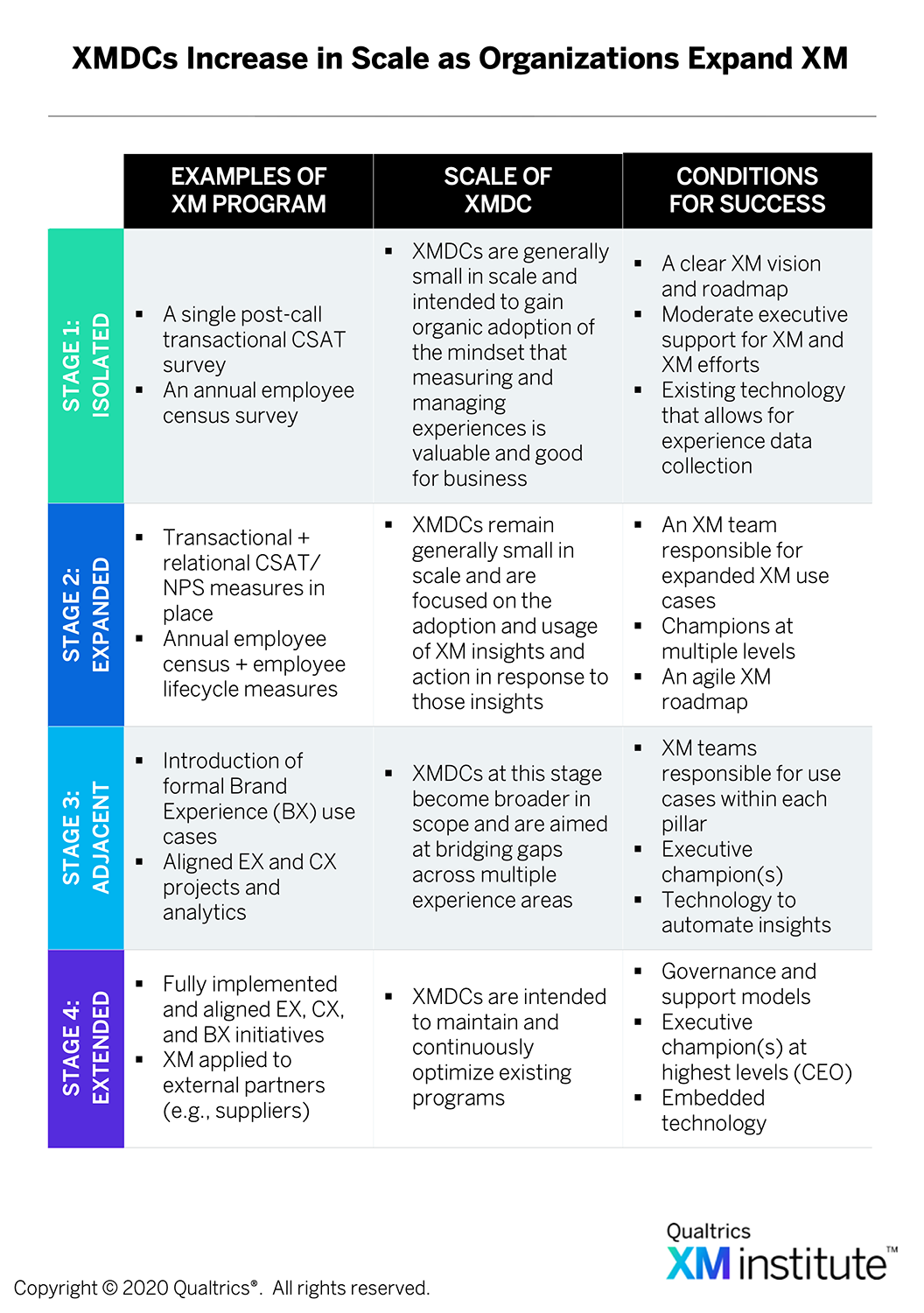 :
:
- Stage 1: Isolated. At this first stage of the XM expansion, the organization is applying XM–centric behaviors and capabilities to only a single or small number of related use cases or specific experiences. For example, a retailer may leverage an annual employee engagement survey as its sole source of EX insights and may only collect CX insights from its direct retail consumers via a post-sale customer satisfaction survey.
- Stage 2: Expanded. Organizations move to the Expanded stage of XM expansion as the application of XM-centric behaviors and capabilities spreads to new areas within the organization, and/or employee, customer, and market segments. For example, the retailer described above may expand its EX program by building systematic lifecycle measures to better understand employees’ experiences with the new hire and onboarding processes. The organization may also expand its collection of CX insights by introducing an annual relational customer satisfaction survey.
- Stage 3: Adjacent. Movement to the Adjacent phase involves the expansion of XM into new experience areas within the organization. For instance, the retailer may observe that the existing transactional and relational CX measures do not fully capture the organization’s future or prospective customers. As such, they introduce a formal BX initiative in the form of a brand tracker. Organizations can also enter this phase as they align previously disconnected experience areas and opportunities. For example, the retailer may collect employee feedback about possible disruptions to the customer experience as it implements a new store-wide point-of-sale system. The retailer may also develop a culture assessment that is administered to its employees to evaluate their perceptions of the organization’s customer-centricity.
- Stage 4: Extended. In the final phase of XM expansion, the organization has spread XM–centric behaviors and capabilities across all experiences that the organization can directly and indirectly influence. For example, now the retailer has fully implemented and aligned its EX, CX and BX initiatives and has extended these practices to its suppliers and distributors, ensuring that the experiences that they indirectly influence must be measured and managed as well.
XMDC: Isolated to Expanded
Through this research, we identified a number of effective XMDCs that are effective for organizations progressing through the stages of XM expansion 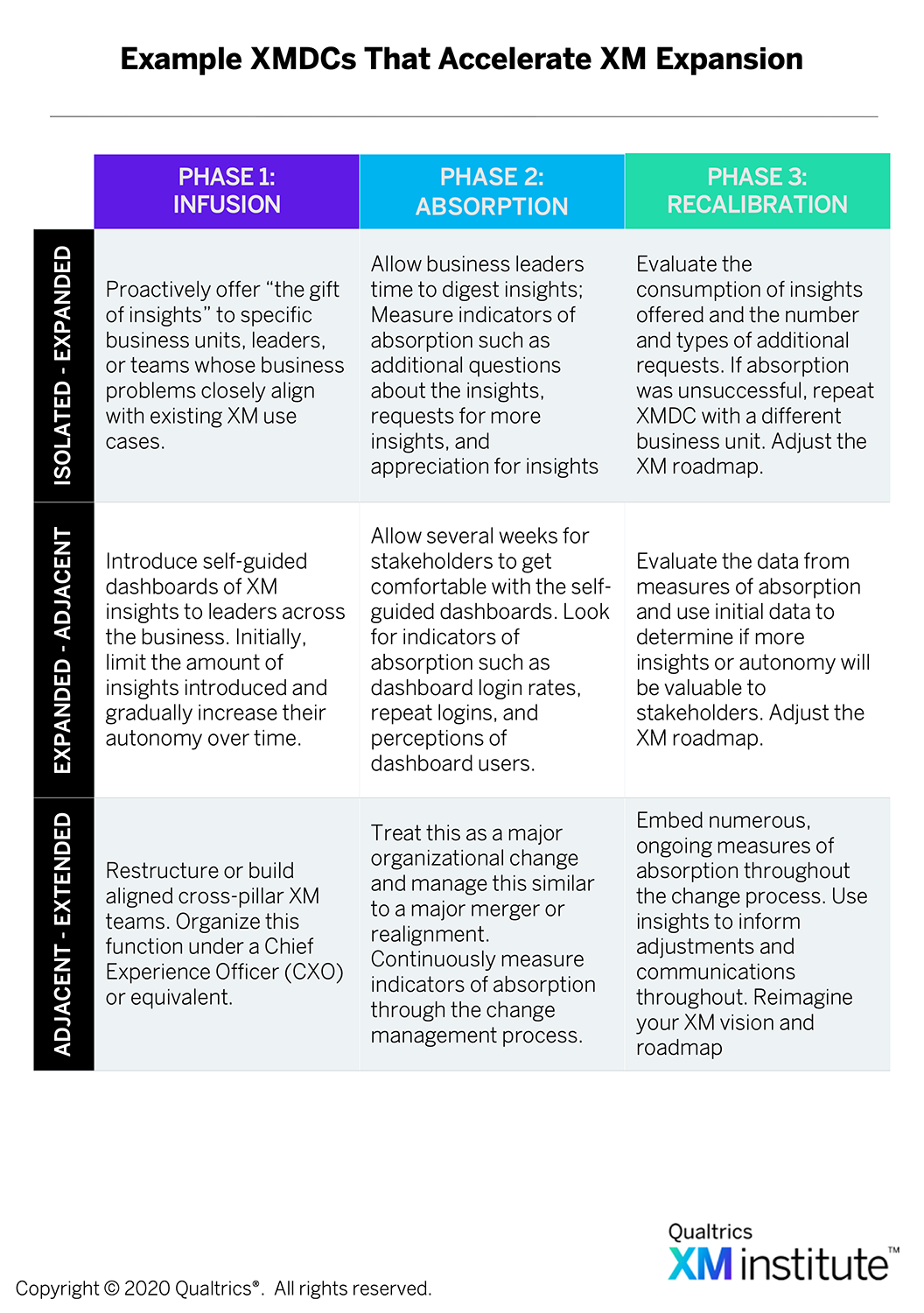 . Here are some XMDC techniques that are effective when moving from the Isolated to the Expanded stage of XM expansion:
. Here are some XMDC techniques that are effective when moving from the Isolated to the Expanded stage of XM expansion:
- Interview key business stakeholders. Interestingly, some of the most fundamental infusion tactics may seem relatively passive. Keep in mind, however, that the success of an infusion tactic is measured by the level and degree of absorption it creates. One newly hired Chief Customer Officer (CCO) began his tenure at a regional bank in the U.S. by simply interviewing business leaders across the organization (infusion). While his mandate was to transform a traditional “customer service” function into a proactive and strategic CX program, his first infusion tactic was to systematically listen. This multi-month process led him and his team to uncover underlying business issues and concerns across the bank. His team used these insights to identify consistencies and key areas where CX could directly impact the business. These interviews led to significant buy-in among key stakeholders by establishing that the new CX function was in place to help them solve business problems (Absorption). The newly formed CX team built upon this absorption to inform its initial CX projects (Recalibration).
- Conduct meta-research on existing insights efforts. Newly-created XM teams often face the challenge of disrupting existing processes. One effective infusion technique is to conduct meta-research on the existing processes and insights-collection techniques. For example, one global auto manufacturer created a talent analytics function in 2017. Prior to that, talent analytics were generated primarily from operational data housed in the Human Resources Information Systems (HRIS) and a biennial census survey that had been in place for nearly twenty-five years. Despite a strong desire within the new team to dramatically change the data and insights collection processes, they conducted surveys and focus groups across multiple levels and functions of the organization (Infusion). Their human-centered research approach led to significant interest and demand across the organization for changes to the current state (Absorption). The team formally and informally measured this demand and allowed their insights to inform the changes they implemented (Recalibration).
- Share the “gift of insights” with others. One of the universal and most powerful early infusion techniques is the sharing of insights from existing programs and use cases. The idea is quite simple – most organizations have existing XM use cases in place that generate insights that are not fully utilized. When implemented successfully, these novel insights create natural demand for more insights (Absorption). The measurement of that increased demand from the business helps to determine when the next infusion tactic is appropriate (Recalibration). One American automaker has leveraged this technique to build employee experience into its culture by gradually sharing relevant employee insights to its executive staff and board. The Chief Talent Officer leverages insights from a multifaceted EX measurement program to capture just-in-time insights from employees to them. As another example, the CX team of one European tire manufacturer created a deck of playing cards populated with actual customer verbatim comments from its existing consumer surveys. In meetings with various business leaders, the team leverages these insights to support key points and themes. Over time, this simple infusion tactic led business leaders to naturally associate business issues with customer sentiment, and proactively ask for it (Absorption).
- Proactively recruit early adopters and influential champions. In nearly every organization that we studied, there was a relatively small team of XM visionaries and practitioners pushing for more widespread buy-in and adoption of their XM efforts. Some of these teams were created by executive champions with a vision for XM, but many were not. In cases where executive sponsors did not exist or were not active participants in driving XM expansion, successful XM teams proactively recruited influential early adopters across different departments and functions. One Canadian retailer built executive and business support for its early CX efforts through this approach. In the absence of a formal executive sponsor, the core CX team went directly to the regional business leaders with relevant CX insights for those regions and proactively looked for leaders who were struggling on KPIs highly related to customer retention and loyalty (Infusion). Many of these regional leaders became strong champions for the CX efforts of the team and over time, this bottom-up approach to gaining business buy-in was highly effective and naturally positioned the CX efforts as business-critical (Absorption). For the retailer, these champions helped to identify new opportunities for the core CX team that informed much of their work (Recalibration).
- Formally advertise XM successes. One of the first hurdles that core XM teams face is demonstrating the value of their efforts. In most cases, doing so requires the establishment of actions and business results in response to XM activities. The catch is often that in order to demonstrate value, a certain level of investment of time, resources and money is necessary. One prominent mortgage lending company broadly advertises every major action that the company takes in response to every employee census survey (Infusion) in an ongoing effort to build a clear value proposition for every employee in the organization (Absorption). For example, before major survey initiatives, the team advertises by presenting clever quizzes across their major offices. These quizzes ask employees about key changes that were made based on feedback from the most recent surveys. For one healthcare products manufacturer, the analytics and insights team regularly engages in formal “roadshows” across multiple office locations and functions (Infusion). The team not only shares interesting insights with those locations and functions, but they describe actual changes that have been made by their peer locations/functions. This team leverages the natural competitiveness of the leaders across their locations to create absorption and high demand for additional XM insights.
XMDC: Expanded to Adjacent
As organizations progress from the Expanded stage to the Adjacent stage, core XM teams face increasing challenges, such as disconnected organizational functions. In general, the scale and scope of XMDCs at this more advanced stage of expansion increase. Here are some XMDC techniques for this period of expansion:
- Roll out self–guided dashboards. While most organizations collect and report on XM-centric metrics and insights, many do so in very manual ways. For example, in the EX space, it is still common for organizations to conduct an annual census of their workforce and then roll out static reports to senior leaders and people managers. In many cases, these reports take weeks if not months to create and any ad hoc questions that people leaders have require manual computation. One of the most common and effective infusion tactics that we uncovered was the introduction of dynamic and self-guided dashboards of XM insights. For one large telecommunications company in Canada, this dramatically accelerated the progress of their EX and overall XM efforts. As the company transitioned from static EX reports to self-guided dashboards (Infusion), they observed a dramatic increase in personal ownership of the results and widespread action being taken (Absorption). As the Head of Research and Advisory at the company described it, leaders moved from feeling like the results were a “report card” to real-time sentiment that they could directly impact. Importantly, because this tactic impacted nearly every people manager across the company, demand grew naturally for a similar mode of reporting for the company’s CX initiatives and informed many new infusions among different XM teams (Recalibration).
- Create common XM terminology. One of the natural obstacles to expansion from one area like CX to another like EX (the hallmark of the Adjacent phase) is that the functions and XM teams within them have different educational backgrounds and use different models and terminology. While core EX teams are often formally trained in Human Resources and Industrial Organizational Psychology, core CX teams may come from many different areas such as Customer Service, Operations, and Business Administration. Additionally, BX teams are often staffed with traditional Market Researchers and PX teams with designers and User Experience experts. However, several organizations that we studied have made significant progress in aligning the underlying models and terminology used across these teams. For example, one global technology company has introduced broader job titles and roles across these areas that are rooted in XM (Infusion). The tech firm introduced consistent XM-centric models across all pillars of experience while allowing for slightly different operational interpretations within each. This has led to a significant increase in collaboration across their traditional departments (Absorption), which in turn, has led to dozens of XM opportunities for the core XM team (Recalibration).
- Build an executive champion who is involved…but not too involved. Not surprisingly, one of the most powerful enablers of XM expansion is the presence of supportive senior executives. Oftentimes, the initial executive champion comes from a specific function where XM is growing, such as the CMO whose team is building a robust BX and/or CX program or a CHRO whose team oversees EX. We were surprised to find that a “lighter touch” from this executive champion may actually be more effective than a forceful top-down mandate. In one large pharmaceutical company, the CHRO took an active role in building a formal people analytics function to support talent initiatives across the global firm. However, his role was intentionally minimal – focusing on setting a high-level vision for the people analytics function, identifying leaders to create and operate the function, and securing budget for this new function (Infusion). The CHRO enabled this new function to execute on the vision semi-autonomously, allowing them the time and space to operate, which naturally led to more absorption across the business in response to their efforts. Today, this CHRO works closely with the people analytics function to assess progress toward business objectives and update its charter and roadmap (Recalibration).
XMDC: Adjacent to Extended
Once organizations approach the final stage of expansion, Extended, the scale and scope of XMDCs greatly expand. Many infusions represent significant organization-wide changes that directly or indirectly affect everyone within the organization. Here are some XMDC techniques for this final stage of expansion:
- Create adjacent X- and O-data analytics teams. By definition, XM involves the usage of both experience and operational data. In many of the organizations we analyzed, the teams who measure and manage these two data types are in different parts of the organization with minimal alignment. In the organizations where these groups are combined, we found a much stronger environment for XM expansion. In one large telecommunications company, up until 2019, the traditional “people analytics” function sat within the HRIS team and was structurally separated from the “employee experience” team. The closest link between these teams was the CHRO. In 2019, this organization underwent a major restructure which created adjacent employee analytics and experience teams (Infusion). This naturally led to far more powerful insights related to the company’s people, which in turn, led to widespread interest among business leaders (Absorption). According to the head of this newly created EX team, talent analytics have had more impact on this telecom’s business in the last year, than it had in the prior ten.
- Build a dedicated XM function. A more advanced, yet increasingly common, infusion tactic is to create a centralized XM function within the organization. One international credit firm and another large retail bank based in the U.S. have recently completely restructured their organizations around XM. Both organizations have officially created Chief Experience Officer (CXO) functions that bring together cross-functional teams whose shared responsibility is measuring and improving at least one of the core experiences of the business (employee, customer, brand, product). By building these formal XM functions (Infusion), the coordination among XM teams and core business functions (sales, marketing, product development) has naturally and dramatically increased (Absorption). Within these firms, new opportunities, use cases, and infusion tactics often arise from the business and shape the day-to-day work of the XM functions (Recalibration). Ultimately, this XMDC has removed many of the traditional obstacles these organizations have faced in expanding XM efforts.
Managing XM Diffusion Cycles
XMDCs do not occur in isolation. Organizations that successfully expand XM will orchestrate XMDCs over time and sequence them to build upon one another. Here are some recommendations for managing the process:
- Embed XMDCs into your XM roadmap. Nearly every successful, large-scale XM expansion effort that we studied began with explicit documentation of the XM vision and roadmap for the organization. And in the most successful cases, these documents were influenced by and formally included XMDCs. While it is common for organizations to document what are essentially Infusions, specific attention should also be paid to the ideal signals and timelines of Absorption for each XMDC. Additionally, beyond the measurement of Absorption, one of the key characteristics of Recalibration is adjusting the XM roadmap. In short, a foundational step to orchestrating multiple XMDCs is formally embedding every phase of every XMDC into the XM roadmap.
- Orchestrate XMDC portfolio through an XM Program Office. As XM-centric behaviors expand throughout an organization, XM projects and use cases naturally proliferate. This is a common scenario and is in fact, a good sign that organic demand for XM is growing (i.e., absorption). If unbridled, however, this situation can also have negative consequences for the organization and the actual experiences of key stakeholders (e.g., employees and customers). An XM program office is a critical function for orchestrating new and existing XMDCs, XM opportunities, and use cases. To do so, this function must build formal support models to organize the large number of new and existing XM use cases
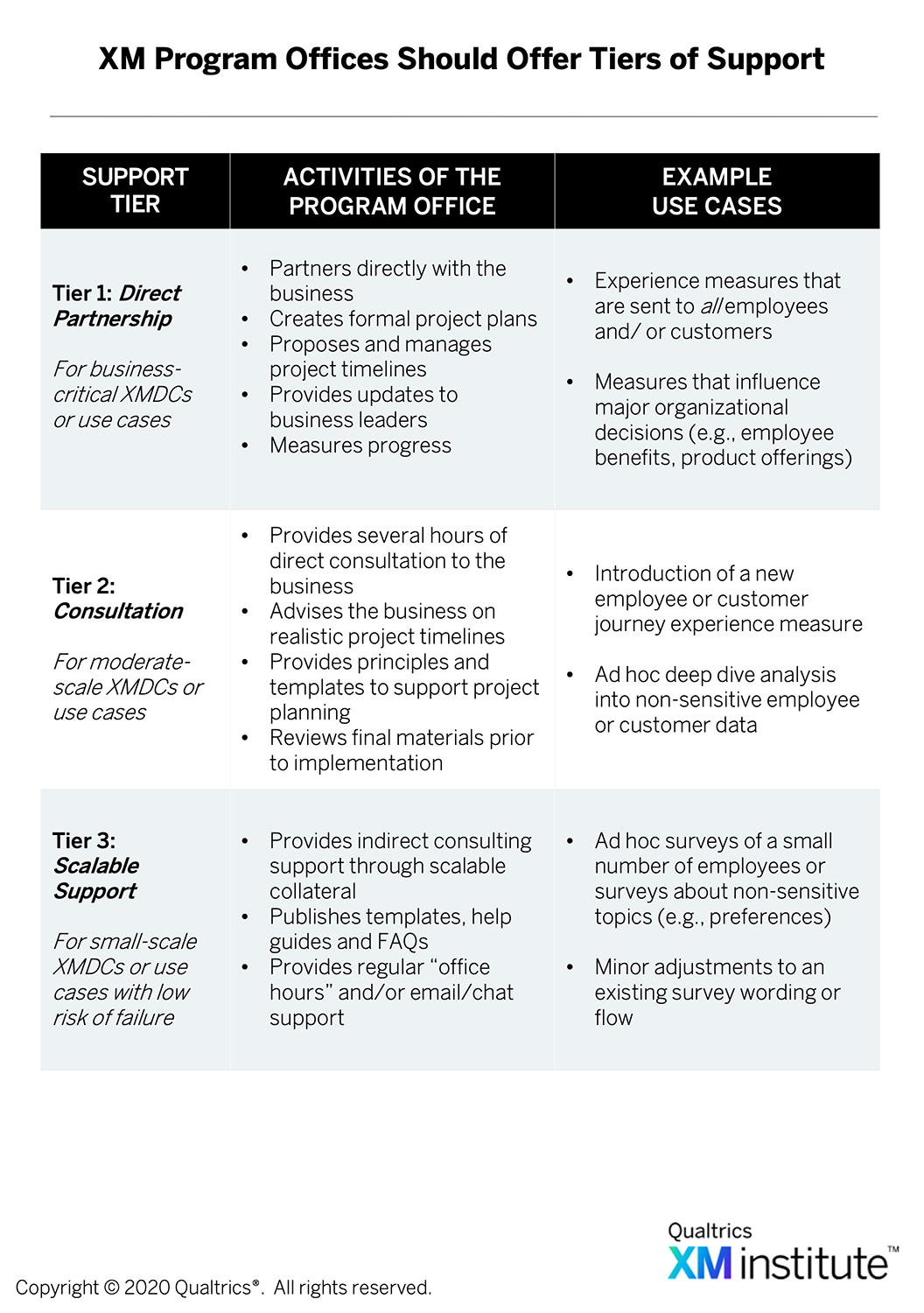 . The XM program office is ultimately the steward of the XM roadmap and each XMDC supporting it, ensuring that XMDCs are appropriately staggered; for example, ensuring that new infusions are only introduced once the ideal signals of absorption from prior infusions are observed.
. The XM program office is ultimately the steward of the XM roadmap and each XMDC supporting it, ensuring that XMDCs are appropriately staggered; for example, ensuring that new infusions are only introduced once the ideal signals of absorption from prior infusions are observed. - Federate XMDCs over time. One of the most fascinating trends among organizations that have expanded XM broadly is that in early phases, they leveraged tactics that were designed to centralize XM functions and activities. In fact, the activities of the XM program office are designed to manage the proliferation of XMDCs and XM use cases. However, as organizations embed XM-centric behaviors and capabilities into their everyday business processes, they naturally federate responsibility of XMDCs.3 For example, an HR manager that previously relied on a centralized XM team for all employee-facing surveys may create a pulse to her organization with specific follow-up action guides and steps based on a template and guidelines set up by the XM program office.





